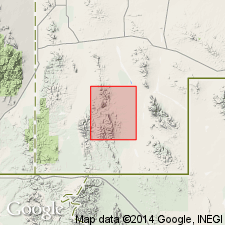
- Usage in publication:
-
- Double Adobe Latite
- Modifications:
-
- First used
- Dominant lithology:
-
- Latite
- AAPG geologic province:
-
- Pedregosa basin
Summary:
First use of name. On geologic map only. No type locality designated. Probably named for Double Adobe Creek, which flows along northeastern boundary of unit in T31S, R19W. Is exposed in T31S, R19W, Walnut Wells quad, Hidalgo Co, NM in Pedregosa basin, and extends westward. Composed of latite flows; rock is dark gray to dark purple, weathers rust brown, contains large, clear euhedral plagioclase phenocrysts and small green phenocrysts of ferromagnesian minerals; has aphanitic groundmass which is locally spherulitic. Is younger than Park Tuff (new). Is equivalent to Pine Canyon Formation and OK-Bar Conglomerate (both new). Is of Tertiary age.
Source: GNU records (USGS DDS-6; Denver GNULEX).

- Usage in publication:
-
- Double Adobe Latite
- Modifications:
-
- Named
- Dominant lithology:
-
- Latite
- AAPG geologic province:
-
- Pedregosa basin
Summary:
Named for Double Adobe Creek, which flows along northeastern boundary of unit. Is exposed in T31S, R19W, Walnut Wells quad, Hidalgo Co, NM in Pedregosa basin, and extends westward into Animas Peak quad. Geologic map. Top not exposed. Consists of ill-defined series of latite flows. Each flow has a tuffaceous oxidized base which grades upward into a vesicular top. Latite is usually dark gray to dark purple, but in places is brown, red, or greenish yellow. Many plagioclase phenocrysts. Matrix varies from dense, massive, and cherty to sperulitic. Well indurated; lacks xenoliths and lenses and is vesicular only at top and bottom of individual flows. Weathers rusty. Not resistant to weathering; forms rounded, gentle slopes covered by small, platy, angular blocks of latite. Curved joints in places. Is equivalent to Pine Canyon Formation (new). Overlies Park Tuff (new), tongues of Pine Canyon, and basal OK Bar Conglomerate (new). Is younger than Park and basal OK Bar; basal beds are interbedded with, and consequently same age as, Pine Canyon Formation, and some OK Bar Conglomerate. Is Tertiary in age.
Source: GNU records (USGS DDS-6; Denver GNULEX).
For more information, please contact Nancy Stamm, Geologic Names Committee Secretary.
Asterisk (*) indicates published by U.S. Geological Survey authors.
"No current usage" (†) implies that a name has been abandoned or has fallen into disuse. Former usage and, if known, replacement name given in parentheses ( ).
Slash (/) indicates name conflicts with nomenclatural guidelines (CSN, 1933; ACSN, 1961, 1970; NACSN, 1983, 2005, 2021). May be explained within brackets ([ ]).

